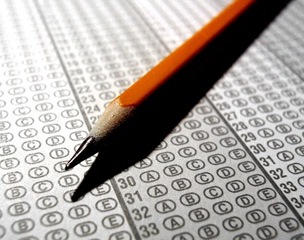
College Board and ACT have a few things in common. Both claim to assess students’ readiness for college. Both claim to be able to predict student success in college. Both report they assess major core academic skill areas. Both will cost a student a full Saturday morning and more than $40 if writing options are pursued. Both are willing to mail a student’s score to colleges afterward. Both also cause tremendous stress, and neither is in Alaska’s time zones meaning West Coast counselors better call early to get a call through.
Studies indicate most students do better on the SAT after a PSAT. Likewise, the ACT Plan offers preparation for the ACT. A second SAT or ACT normally seem to bring higher scores. Studies on third attempts are less encouraging, but with additional preparation, students can improve those as well.
Many students may think that going to bed an hour early on a presiding Friday and having a better than normal breakfast on Saturday morning will suffice as solid preparation. What some students may forget is that scores are relative.
These are not criterion-referenced tests to assess sheer competence. It’s all about how one college bound senior compares to another. Furthermore, 100 percent of those seniors want to be in the top 10 percent or 20 percent of results. Anyone worthy of solid math scores has the math aptitude to know that you won’t fit that large group in that small subset no matter how hard you press.
Some major differences separate the two tests. ACT has four tests: Reading, Math, English, Science meaning reading accounts for a quarter of the total Composite that is derived by averaging scores. SAT has 10 total tests assessing Critical Reading, Writing and Math. Those three areas are added to come up with a Total Score.
Interestingly, while colleges collecting ACT scores want ALL scores, many colleges requesting SAT scores ONLY want Critical Reading and Math citing lack of longitudinal studies to support the relevance or validity of the Writing Test. While it may be that, or simple reluctance to change after SAT changed their tests, it may leave student less sure which SAT subtests are more critical in their overall score reports.
Some myths exist for tests as well. More people may believe the SAT is more accepted based upon the fact that more sign up for and take the SAT each year. That is not my experience. Most colleges will gladly accept either. If Googled, any student can download a charge showing how one score compares to scores on the other test. Insuring that ACT is also widely used, ACT is even mandated in some states by their state departments of education.
Another myth revolves around their focus. SAT is often perceived as more language based measurements of one’s aptitude (vs. achievement). Think of achievement as what one has already learned and mastered in the past while aptitude is viewed as that which one may be able to do in the future. In fact, many students taking both tests find comparable scores using conversion charts when they compare the sets of scores.
Another myth is that test scores are the Be-All, End-All for admissions and scholarship offers. While some schools still view GPA and tests as the only variables requested, there are many others that either view this as only one of many worthwhile predictors or even a minor consideration in admission decisions. Even with more schools claiming to be more balanced in admission decision, it is always to the advantage of students to strive for the best possible scores on one, or the other or both.
Preparation certainly seems to the key to earning the best possible scores. The U.S. military bought the rights to the Peterson’s Test Preparation Program. To get the full benefit of taxpayer’s dollars, students should go to www.March2Success.com and register. The rewards of this registration is full access to seven practice ACT AND SAT tests as well as flashcards designed to improve scores.
Because these tests are timed, the timed practice tests more closely simulate actual tests. Because anxiety can be triggered by timed tests, these can approximate more test-like conditions and make the practice more meaningful. Likewise, SAT has offers for Score and Answer Reports in May and October. For $18 students can now get more than simple scores. They can see the particular strengths and weaknesses and allow that test to serve as a study guide for a subsequent test attempt.
These tests offer more as a preparatory instrument than the simple materials produced by College Board or ACT. Their materials may be meant more to simply familiarize students with the type of questions than to actually improve scores. This leads me to my recommendations. I always recommend an ACT Plan and a PSAT early in high school. Studies suggest these help subsequent SAT and ACT test scores.
I always recommend students take the first SAT and ACT at the end of their junior year, practice hard over the summer with March2Success and take the October SAT and ACT so scores are back in time to submit for even Early Action college applications. Of course, recommending students do this sequence is no guarantee students will do so. In Alaska, there is a new guarantee warranting this sequence.
Alaska has a new Alaska Performance Scholarship that gives up to a full four year tuition award if three preconditions are met: rigorous curriculum, high GPA and solid test scores. If our students can achieve a 25 ACT or 1680 SAT Total, they have met 1/3 of the formula demands to attend a University of Alaska. Other states have similar models in place making the $40 plus fees worth every penny or more.
This leaves the only real decision whether the ACT Essay is worthwhile. While a requirement on the SAT, testers can opt to take an essay test on the ACT. Both tests allow samples or examples of their prompts available on test readiness materials. ACT’s website has a worthwhile search tool that allows testers to enter the name of the state at which they are planning a college career. All schools will be listed as one Recommending, Requiring or Not Needing the extra essay that allows 30 minutes to demonstrate their essay writing skills.
One money saver for students is how scores are reported. If students identify up to four schools to which they want a set of scores sent at the time of registration, SAT and ACT will happily send them for free. This may not be necessary. If students call their schools of choice, they may find the college may happily take scores reported on official transcripts. Most schools will happily send those transcripts at no cost to students or a fee less than that sought by College Board or ACT.
Furthermore, some schools will accept transcripts reported scores for admission consideration and only required official ones directly from ACT or SAT after final transcripts are submitted for admitted students once they are committed to that school.
Students should ask whether schools might combine scores as another question. That question is the reason students should decide whether they want to submit any one set of scores directly from SAT or ACT. Students will only know that answer if they call the school directly. It is always worth noting the name of the answering admission officer along with the date and time of the call in their notes.
While the actual questions are supposed to be the hardest part of the test, the most time consuming part may be the rehearsals, practice exams, reporting and submissions of test scores. Perhaps the highest toll may be the costs unless students are receiving Free or Reduced Lunches allowing them to take two free tests as juniors and seniors (that also allows them to apply to some colleges for free). In fact the greatest toll may actually be the anxiety of preparing for the test, then taking the test and finally awaiting test results. Students can comfort themselves that if they prepare and practice, they can and will do better than they would if they did NOT invest time practicing.



